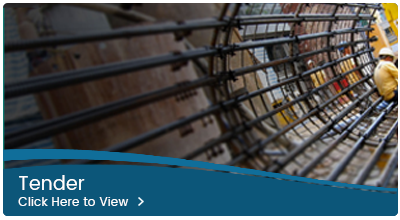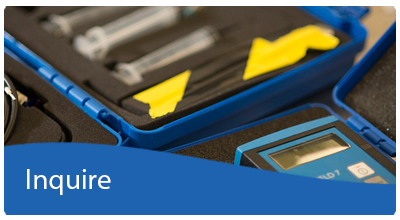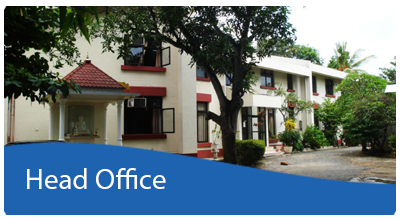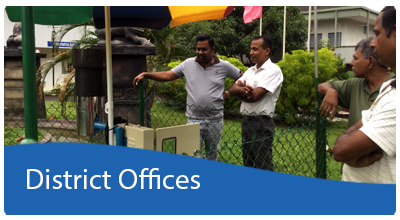Research & Development Program
1. Determination of regional and local rainfall thresholds for landslides in Sri Lanka.- LRRMD
2. Design a Transitional shelter for disaster affected communities.- HSPTD
3. Development of cost effective green masonry products using textile waste and coal fired oiler ash.- BMD
4. Development of alternative fibers to asbestos fibers for roofing materials.-BMD
5. Development of guideline for selection of materials and products for construction industry - BMD
6. Development of geotechnical guidelines for high-rise buildings - GED
7. Analyze the effect of meteorological, environmental and anthropogenic factors attributed to drought severity and sector based water stress in Anuradhapura District. – ESSD
· Sustainable roof based rainwater harvesting system to overcome domestic water deficit conditions in the Anuradhapura
· Hydrological functions of small tank eco systems and its role in sustainable water management: to use as evidence based technical guidelines for small tank rehabilitation.
8. Preparation of Technical Guidelines for Building Demolition work in Sri Lanka. – PMD
1. Development of a method to process water treatment sludge to extract clay to manufacture high quality clay products-BMD
2. Analyzing of the ground vibrations of rock quarries in Sri Lanka and proposed suitable limits for ground vibrations which can cause minimum effect to the landslides-LRRMD
3. Develop methodology to conduct Social Impact Assessment (SIA) for structural landslide mitigation measures-HSPTD
Development of guidelines for selection of materials and products for construction industry.
By: Ms. Madushani Ariyadasa, Scientist (Engineer)
Building Material Research and Testing Division. NBRO
With the emerging construction activities in the construction sector of Sri Lanka, imported construction materials and products are being frequently introduced, but without a proper introduction, many of them are unknown to Engineer, Architect or Quantity Surveyor. Hence in certain instances, these professionals are unaware on specifying certain such materials in their bidding document. Therefore it is a timely need to introduce a kind of guideline to select, specify and evaluate those materials and products. With the main objective of aforementioned, a handbook which describes the guidelines is developed in this project proposed by Building Material Division of NBRO on assisting construction professionals for selecting appropriate materials necessary for specific requirements.
The Methodology adopted in this project is to collect the information presently available on construction materials and their characters, to evaluate them and to combine them into a single document. This single document will be a handbook which finally gives a comprehensive information on construction materials and products indicating their properties, test methods and specifications relevant to local and international standards.
The handbook will be formulated in four volumes and it will basically cover the following materials/products.
Volume I – Building Works (Aggregate, Cement, Water, Concrete, Aluminium, Glass, Water proofing, Structural steel, Sealant, Blocks, Bricks etc.)
Volume II- Sanitary Installations (Tiles, PVC pipes, Water closets etc.)
Volume III – Electrical/Data Installation (Wires & Cables, Electrical conduits & fittings, Electrical enclosures, Circuit breakers, Electrical Boxes etc.)
Volume IV – Building Services (Elevators & Escalators, Fire Fighting System, HVAC etc.)
Currently, the formulation of Volume I has already been started and it will consist of around 160 numbers of construction materials and products. As of now, gathering of the information on Cement, Aggregate, Admixtures, Supplementary Cementitious Materials, Mortars & Plasters, Timber, Water Proofing, Glass and Aluminum have been completed. The basic structure of the handbook will be as follows.
|
Item No |
Product/ Materials |
Application |
Relevant standard/s |
||
|
Property |
Test methods |
Requirements |
|||
|
1 |
Glass |
Interior and outer usage in Building |
Resistance against manual attack |
||
|
|
-Hard body drop test |
BS EN 356 :2000 |
BS EN 356 :2000 |
||
|
|
-Axe test |
BS EN 356 :2000 |
BS EN 356 :2000 |
||
|
|
Luminous and solar characteristics of glazing (As per BS EN 1096-1-2012) |
||||
|
|
-Light transmittance |
BS EN 410:2011 |
BS EN 1096-4:2018 |
||
|
|
-Light reflectance |
BS EN 410:2011 |
BS EN 1096-4:2018 |
||
|
|
-Energy transmittance |
BS EN 410:2011 |
BS EN 1096-4:2018 |
||
|
|
-Energy reflectance |
BS EN 410:2011 |
BS EN 1096-4:2018 |
||
|
|
Determination of thermal transmittance (U Value) ( As per BS EN 1096-1-2012) |
||||
|
|
- Calculation method |
BS EN 673:2011 |
See note1 |
||
|
|
- Guarded hot plate method |
BS EN 674:2011 |
See note1 |
||
|
|
- Heat flow meter method |
BS EN 675:2011 |
See note1 |
||
|
|
Bullet resistance |
BS EN 1096-4:2018 |
See note1 |
||
|
|
Emissivity |
BS EN 12898:2001 |
See note1 |
||
|
|
Glazing and airborne sound insulation |
BS EN 12758* |
See note1 |
||
|
Partition, Fully , partially and uninsulated, insulated door sets, Shutter assemblies, Celling membranes and glazed elements |
Determination fire resistance |
BS 470-20 |
BS 470-20 |
||
|
1The user may decide as per the design specification |
|||||

































